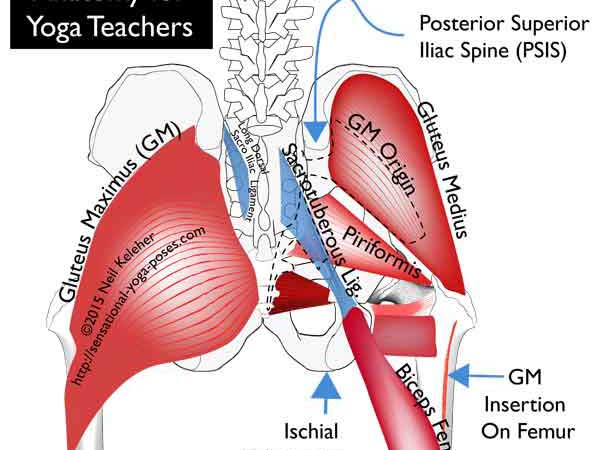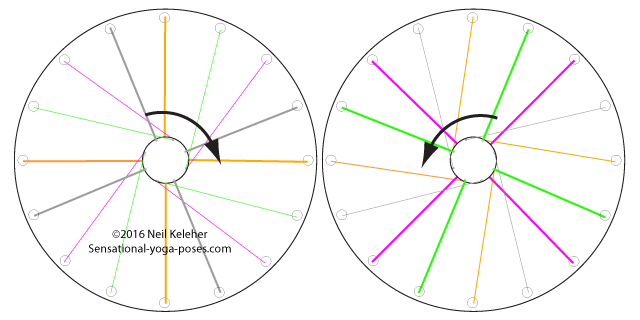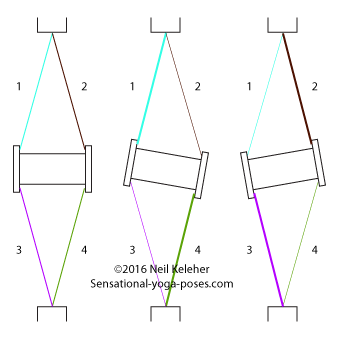Sitting bone and sacrotuberous ligament pain
Understanding your hip joint so that you can alleviate pain more efficiently
When trying to understand how to deal with sitting bone pain or sacrotuberous ligament pain, it can be helpful to think of ligaments as active structures. They can (and are) affected by muscle tension. Even more helpful is understanding which muscles can directly (and indirectly) affect tension in the sacrotuberous ligament.
Also helpful to understand is that ligaments don't just come into play at the end of a range of motion. Instead, they can be used to help protect joints through a wide range of movement.
Rather than preventing bones from bumping into each other at the end range, they help to maintain joint space, i.e. prevent joint surfaces from rubbing.
Where is the sacrotuberous ligament located?
The sacrotuberous ligament is a span of connective tissue that connects the sacrum to the ischial tuberosity. The sacrum is the downward pointing triangle of bone at the base of the spine. The ischial tuberosity, which most people call sitting bones are the two bones you can feel when you sit down (which you probably already knew bearing in mind the title of this article).
What does the sacrotuberous ligament do?
Part of what the sacrotuberous ligament does is help to protect the si joint. It can help to protect the SI joint when the sacrum is nutated. (This is where the sacrum nods forwards relative to the hip bones).
Muscles that can affect sacrotuberous ligament tension
Muscles that can add tension to this ligament include the gluteus maximus, the hamstrings and possibly the piriformis. All of these muscles have direct attachments to the ligament. Different muscles can be used to create nutation of the sacrum, and thus add tension to the sacrotuberous ligament.
Those include the spinal erectors, and in particular the lumbar multifidii (which extend into the sacral region), the oburator internus and gemelli, quadratus femoris, the lower band of the transverse abdominus, sartorius.
Note that many of these muscles are muscles that work on the hip joint.
How the sacrotuberous ligament is affected by positioning of the hip joint
While the sacrotuberous ligament helps to stabilize the SI joint, it can be strongly affected by the hip joint, more specifically the relationship between femur and hip bone, since this in turn can affect the muscles that act on the sacrotuberous ligament.
The benefits of optimal positioning
Optimum positioning given whatever it is that you are doing allows muscles to activate in such a way that they keep the hip joint and si joint safe. Less than optimal positioning may inhibit muscles by making the distance they span too long or too short. This can have a knock on effect. If one set of muscles can't activate, then opposing muscles may also be inhibited since muscles need an opposing force to work against for sustained activation.
This in turn can result in a lack of stability. This in turn can affect other muscles which need a stabilized end point for effective operation.
Integration becomes more critical with greater forces and more extreme positioning
Note that this may not be so important when dealing with lesser forces or with less extreme ranges of motion. However, when dealing with greater forces or when working at extreme end ranges, greater integration is required. And so why you may not feel sacrotuberous pain while walking, or doing everyday activities, but you may get it while stretching or running.
To get a better grasp of this idea, you could hold off a child pushing you with one hand and little or no extra bracing required. Your mass and strength is sufficient. However, working against a larger child or person with more mass and strength, you have to brace more of your body to withstand being pushed.
This analogy can apply to the differences between walking and running (and to stretched positions versus not stretched positions).
The relative stresses of running and stretching
For running, you need more bracing to handle the forces of impact.This bracing can start just prior to impact and for a bit afterwards.
For stretched positions, the deeper you go, the more bracing you'll need.
Playing with leverage when stretching
Note that with stretching positions, you can vary the amount of force in a stretch by playing with leverage and support. For example, in a seated forward bend you can support upper body weight with your arms. Or you could lift your arms. Or you could reach your arms forwards. Each of these positions places a different load on the muscles that are being stretched. Depending on how you use your muscles to act on your hip and your SI joint, (and this applies to running also) you may or may not get sacrotuberous pain.
How greater leverage (or greater moment arms) can cause sacrotuberous pain
Bearing this in mind, you may find that you get sitting bone pain or sacrotuberous pain in different poses, or in different positions while entering or leaving poses. For example you may find that in the bottom position of a standing forward bend you feel fine, but when you stand up, you get pain. Or you may find you get pain when you use your arms to pull yourself deeper into the pose. Or you may find that it's the opposite, you get pain when you don't use your arms.
Modelling the hip joint using a bicycle wheel
To understand the hip joint a little easier, I find that for myself it helps to visualize the hip joint and it's muscles as similiar to a spoked bicycle wheel. The hip bone acts as the rim and the neck and ball joint of the femur act as the hub. Meanwhile the muscles of the hip, both the single joint hip muscles and the multijoint hip muscles that can work additionally on the SI joint, the lumbar vertebrae or the knee joint, all of these can be thought of as spokes.
Varying tension in these spokes can be used to turn or move the hub relative to the rim or vice versa.
Adding tension to the gray spokes causes the hub to rotate clockwise.
Adding tension to the green spokes causes the hub to rotate counter-clockwise.
Tension in these "spokes" can also be used to help keep the hip joint centered in any position and no matter what forces are acting on it.
Using muscle tension to keep the hip joint "centered"
Now rather than being like a bicycle wheel with all of the spokes tensioned all of the time, for our bodies, it might be better to understand that our muscles come on line when required to help keep the hip joint centered.
(Note that in his book better movement, Todd Hargrove uses the term centration to refer to this same idea. While he uses the term consistantly, and because of that the reader knows at each time what he's talking about, there's a part of me that thinks the term itself is ridiculous. Why not just say "centered"? While I've written an article about centration, the term I preferred to use is centered.
The nice thing about this term is that you can use it to mean more or less the same thing in a variety of contexts. As an example of this, learning how to file pieces of metal accurately while learning trade training in the British army, we were taught to stand with our weight "centered" over our feet. We had to position ourselves relative to the piece of metal that we were working on so that we didn't overextend ourselves, so that we could remain "centered".)
Keeping the hip joint centered and lubricated
The hub of a bicycle wheel has two flanges. Tension to both of these flanges has to be balanced for the hub and rim to be correctly aligned. In terms of our hip joint, it helps to think of balance not just when viewed from the side, but also when viewed from the front.
I'll come back to this later. The key point to understand is that as well as driving movement, the purpose of the hip muscles is to help keep the hip joint centered and also to keep it lubricated.
Providing the obturator internus with resistance and giving it sufficient span to operate
I've already written in depth about the obturator internus and how it can be used to create an outwards pull on the sitting bones, assuming that the thigh bone is stable and also assuming that other muscles come into play to help resist the pull of this muscle.
Since the obturator internus creates an outward pull on the sitting bone, you need something to resist this pull. That can come from inwards movement of the ASIC being resisted. That resisting force can come from the gluteus minimus. It can also come from the tensor fascia latae.
Pulling the hip bone rearwards
The obturator internus also needs sufficient span (or "length) in order to effectively activate. The muscle can tend to pull the hip bone forwards. To resist this pull the pectineus (and/or the iliacus and or the psoas) can be called into play to create a rearwards pull near or at the pubic bone. Obturator externus may also help in this regard.
Balancing adduction forces with abduction forces
Obturator internus, and the other muscles mentioned so far may also tend to try to adduct the hip joint pulling the femur inwards relative to the hip bone. Standing on both legs, the opposite leg can be used to resist this tendency. However when walking or running or simply standing on one leg, you need the abductors, including the previously mentioned gluteus minimus but also the gluteus medius as well as the superficial fibers of the gluteus maximus (these are the fibers that attach, along with the tensor fascia latae to the IT band).
For myself and my recent bout of sacrotuberous pain, I've found this latter point the one that helped. That being said, I also experimented with pulling back on (and otherwise controlling) the pubic bone as well as the sitting bones.
For simple lessons on how to feel and control your hip bones and the hip muscles using simple muscle control exercises that you can use in the context of yoga poses as well as while walking and even running, check out my hip bone control course.





